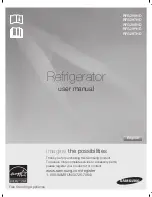
7
Phase Loss Monitor
The combination phase sequence and loss monitor relay
protects the system against phase loss (single phasing), phase
reversal (improper sequence) and low voltage (brownout).
When phase sequence is correct and full line voltage is present
on all three phases, the relay is energized as the normal
condition indicator light glows.
NOTE: If compressor fails to operate and the normal condition
indicator light on the phase monitor does not glow, then the
supplied electrical current is not in phase with the monitor. This
problem is easily corrected by the following steps:
1.
Turn power off at disconnect switch.
2. Swap any two of the three power input wires.
3. Turn power on. Indicator light should glow and
compressor should start.
4. Observe motors for correct rotation.
Recommended Refrigerant Piping Practices
The system as supplied by
Heatcraft Refrigeration Products
,
was thoroughly cleaned and dehydrated at the factory. Foreign
matter may enter the system by way of the evaporator to
condensing unit piping. Therefore, care must be used during
installation of the piping to prevent entrance of foreign matter.
Install all refrigeration system components in accordance with
applicable local and national codes and in conformance with
good practice required for the proper operation of the system.
The interconnecting pipe size is not necessarily the same size
as the stub-out on the condensing unit or the evaporator.
The following procedures should be followed:
(a) Do not leave dehydrated compressors or filter-driers on
condensing units open to the atmosphere any longer
than is absolutely necessary.
(b) Use only refrigeration grade copper tubing, properly
sealed against contamination.
(c) Suction lines should slope 1/4" per 10 feet towards the
compressor.
(d) Suitable P-type oil traps should be located at the base of
each suction riser of four (4) feet or more to enhance oil
return to the compressor.
(e) For desired method of superheat measurement,
a pressure tap should be installed in each evaporator
suction line in the proximity of the expansion valve bulb.
(f)
When brazing refrigerant lines, an inert gas should
be passed through the line at low pressure to
prevent scaling and oxidation inside the tubing.
Dry nitrogen is preferred.
(g) Use only a suitable silver solder alloy on suction and
liquid lines.
(h) Limit the soldering paste or flux to the minimum
required to prevent contamination of the solder
joint internally. Flux only the male portion of the
connection, never the female. After brazing, remove
excess flux.
(i) If isolation valves are installed at the evaporator, full port
ball valves should be used.
Figure 4. Example of Pipe Support
Refrigerant Pipe Support
1. Normally, any straight run of tubing must be supported
in at least two locations near each end of the run. Long
runs require additional supports. The refrigerant lines
should be supported and fastened properly. As a guide,
3/8 to 7/8 should be supported every 5 feet; 1-1/8 and
1-3/8 every 7 feet; and 1-5/8 and 2-1/8 every 9 to 10
feet.
2. When changing directions in a run of tubing, no corner
should be left unsupported. Supports should be placed a
maximum of 2 feet in each direction from the corner.
3. Piping attached to a vibrating object (such as a
compressor or compressor base) must be supported
in such a manner that will not restrict the movement
of the vibrating object. Rigid mounting will fatigue the
copper tubing.
4. Do not use short radius ells. Short radius elbows have
points of excessive stress concentration and are subject
to breakage at these points.
5. Thoroughly inspect all piping after the equipment
is in operation and add supports wherever line vibration
is significantly greater than most of the other piping.
Extra supports are relatively inexpensive as compared
to refrigerant loss.
Figure 5. Condensing Unit / Compressor to Wall Support.
Summary of Contents for H-IM-FL1A
Page 18: ...18 Control Circuit Wiring Diagram for BACU51 and BACU59 ...
Page 19: ...19 Submittal ...
Page 20: ...20 Submittal ...
Page 22: ...22 Notes ...
Page 23: ...23 Notes ...








































